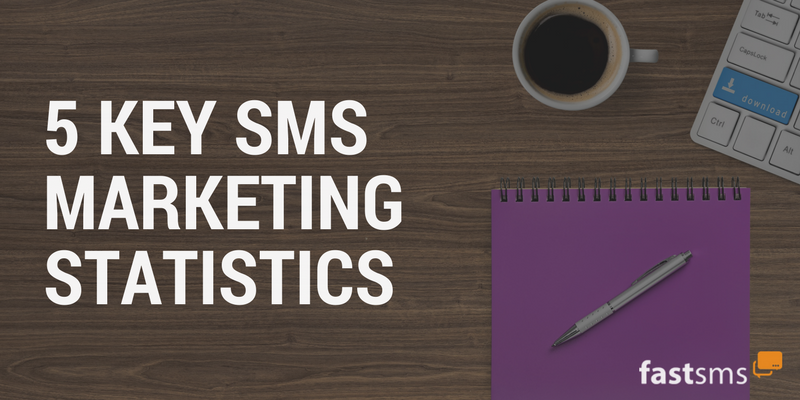24 Key Research Statistics that Prove You Should be Using SMS Marketing

SMS marketing has been a particularly popular way of staying in contact with customers – both potential and existing – since the early 2000s across Europe and some areas in Asia.
It has proved itself to be surprisingly effective and can range from individual messages to text marketing on a large-scale using a cloud-based platform such as FastSMS.
If you find yourself needing to justify putting budget towards SMS marketing or convincing your manager that it’s the right decision for you, here are some key stats to keep in mind for why you should pursue an SMS campaign…
Accessibility
One of the key reasons why SMS marketing is so popular is the fact it is such an accessible and widespread way of contacting people. According to Pew Internet, 97% of Americans use their phone to text every day.
In fact, MBA Online found that over 4.2 billion people send texts worldwide. That’s a huge amount of people actively using the method in which you would be contacting them with.
They are an engaged audience that are used to sending and receiving text messages. It has a very familiar feel for them – so receiving SMS messages wouldn’t come as any great surprise.
Popular Communications
Statistic Brain reports that over 560 billion text messages get sent worldwide every month – and every day (not including app to app), 18.7 billion texts are sent globally. Adding to this, USA today has found that the average adult spends at least 23 hours per week texting.
Nielsen quotes that text messaging is, in fact, the most used data service in the world. Indeed, it’s a marketing opportunity with great potential and with so many text messages flying around the globe each day, hour and minute, it’s the perfect platform to be tapping in to.
Handset Addiction
Not only are millions – make that, billions – of people texting each day, but they’re also addicted to their handsets. Pew Research found that 25% of smartphone owners aged between 18 and 44 claimed they couldn’t recall the last time when they didn’t have their smartphone next to them.
In addition to this, 44% of mobile users have gone to bed with their phone beside them because they feared missing calls, text messages and updates throughout the night. When customers have their phones next to them so frequently, it also means you too have a prime and active audience.
Unlike billboard advertising, in which you might capture someone’s attention for a brief moment, SMS messaging allows for much more constant, intimate engagement. You are reaching people on their handsets in all manners of situations, often when they are relaxing at home and are more open to receiving marketing communications.
Interactions
As a result of how many people send text messages each day and how often users spend on their devices, SMS messaging is a great way of interacting with customers. It is also a method that is highly regarded by the recipients.
In fact, the Direct Marketing Association has found that 44% of consumers prefer to receive details about products and marketing messages through text messages. Meanwhile, RingCentral has found that 78% of phone users would prefer to speak with a business via text than any other method of communication.
When it comes to contacting customers about scheduling or changing appointments or making and confirming reservations, most people prefer text. It offers a very physical form of communication that can be carried around with them wherever they go and referenced when needed.
It is the same as having a paper leaflet or business card but without the worry of losing it – and saves the hassle of trying to make notes while on the phone (in which messages can be misheard or misunderstood).
Gaining Attention
In 2014 The SMS Advantage Report (PDF) conducted by SAP & Loudhouse Research found that 70% of those asked agreed that SMS text messaging was a good way for a business to get their attention.
Part of their success is the fact that text messages have a very high open rate. In fact, Venture Beat claims that the average open rate for a text message is 98%. Forbes has likewise found that within three minutes of being sent, 95% of text messages will have been read.
This is an incredibly strong response for a method of communication with customers – much higher than e-mails, in which people often receive a lot of spam and are used to deleting them before they’ve even read them. SMS messaging is a much quicker and more efficient means of accessing customers as a result.
Effectiveness
Cellit has found that text messages are at least eight times more effective in engaging customers, while eMarketer found that mobile offers get redeemed up to ten times more frequently than print offers.
In November 2015, the Ericsson Mobility Report found that 77% of people will opt into a brand’s SMS messages for coupons or deals, while 50% will sign up for personal alerts. 48% will want to stay in the loop while 33% will be seeking more meaningful content. Finally, 31% sign up because it saves them from having to visit a website, app or physical location for information.
Given how popular SMS messaging is and the many reasons people have for signing up, it’s important to optimise on this with your campaign and offer a diverse and versatile chain of content in which you are tailoring to each of these customer interests and desires.
Building Relationships
SMS messaging is a great way of building a strong and positive relationship with customers, as shown by The SMS Advantage Report – 74% of all those who responded claimed businesses that interacted with them through text messages led to an improved overall impression towards the company.
They also claimed that SMS messages helped towards them feeling as though they are being cared about and like how they can be in control of the services they’re receiving. Part of this comes through being consistent in communications, but not so insistent that it becomes frustrating how often texts are received.
It needs to feel natural for your business and the frequency should reflect how many times you would naturally need to contact them (i.e. a hairdresser messaging weekly might seem a bit excessive when you would only get your hair cut every few months).
Favourite Method of Communication
According to the 2014 Mobile Behaviour Report conducted by Salesforce, 91% of those who opted in to receive text messages found them to be somewhat or very useful. Meanwhile, RingCentral has found that 80% of professionals are currently using texts for business purposes.
Finally, eWeek found that of all other communication channels (including phone and Facebook), texting was rated as the highest contact method for customer satisfaction. Additionally, over one-third of professionals commented that they struggled to go more than 10 minutes without responding to a text.
Get in Touch
It’s time to take advantage of what SMS messaging can bring to your company. Get in touch with FastSMS now to find out how we can help you with business text messaging.
Related Articles
Why People and Companies Prefer SMS Messaging for Customer Support
People like SMS messaging. They really do. In a variety of surveys and studies, consumers continue to say they like it when companies use SMS to communicate with them. Let's look at some of the data that proves it to be true, and also how to make sure your company is using it correctly for customer support communications.
SMS vs. Instant Message App Marketing
It seems there's a new messaging app popping up every month. It's hard to keep track of them all, but it's also hard to ignore them if you're looking to use mobile marketing. When you've got limited marketing resources, should you spend them advertising on the latest IM app, or go with SMS marketing?
3 Tips to Help You Time Your SMS Marketing Campaign
Timing is everything. While it’s an axiom everyone can understand and agree on, it’s doubly true when it comes to SMS marketing. If you send your messages at the wrong time, you’ll see your opt out rates jump and your ROI plummet. So when should you send your text marketing messages? Here are three key guidelines to help you schedule your next campaign.
A2P SMS Messaging Market is Complex, But Growing
I came across an interesting article regarding the A2P market. It’s entitled “Growing Employment Rate to Benefit BFSI A2P SMS Market in Switzerland.” The contents summarise a new report from Transparency Market Research about the A2P market in Switzerland, specifically how it relates to BFSI or Banking, Financial Services, and Insurance (BFSI). You might be thinking that sounds boring rather than interesting, but what drew my attention was the relationship of employment to A2P SMS messaging.
What Your Customers Want From SMS Marketing
Mobile marketing offers an unprecedented access to your customers virtually any time, anywhere. This is particularly true for SMS marketing because it is “always on”. Customers don’t have to be surfing the web, or using an app to receive messages. Instead, they see the marketing messages right alongside ones from their friends and family.
Salesforce Finds SMS Messaging a Growing Part of Mobile Marketing Strategy
What do 5,000 marketers from ten different countries say about SMS? It’s great, and we’re going to do more of it. Well, that’s the gist of the results in the Salesforce 2015 State of Marketing Report. Mobile marketing has taken a central place in most company’s strategies, and SMS is a growing part of it. Here are some key statistics from the report.
Email vs. SMS Revisited
The digital marketing age has really given us so many options when it comes to running campaigns. If you Google “digital marketing channels”, you’ll get article after article about which ones work the best. Of course, most of them won’t completely agree. Here we take another look at how email and SMS measure up against each other.
3 Reasons SMS Messaging is Good For The Environment
Many organisations are looking to operate in a more environmentally friendly way. This includes everything from their office supplies, materials used in creating their products, and also choosing suppliers and vendors that are also environmentally aware. And now, SMS.
5 Key SMS Marketing Statistics
Proof SMS Messaging Gets Results: Increase Sales
Can SMS marketing increase sales numbers? In the next entry of our Results Series you’ll see the kinds of results that real companies achieved. We’ve rounded up sales numbers and timelines to show you how well, and how fast, SMS marketing can improve your sales.












